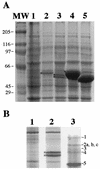Characterization of dacC, which encodes a new low-molecular-weight penicillin-binding protein in Bacillus subtilis
- PMID: 9733705
- PMCID: PMC107527
- DOI: 10.1128/JB.180.18.4967-4973.1998
Characterization of dacC, which encodes a new low-molecular-weight penicillin-binding protein in Bacillus subtilis
Abstract
The pbp gene (renamed dacC), identified by the Bacillus subtilis genome sequencing project, encodes a putative 491-residue protein with sequence homology to low-molecular-weight penicillin-binding proteins. Use of a transcriptional dacC-lacZ fusion revealed that dacC expression (i) is initiated at the end of stationary phase; (ii) depends strongly on transcription factor sigmaH; and (iii) appears to be initiated from a promoter located immediately upstream of yoxA, a gene of unknown function located upstream of dacC on the B. subtilis chromosome. A B. subtilis dacC insertional mutant grew and sporulated identically to wild-type cells, and dacC and wild-type spores had the same heat resistance, cortex structure, and germination and outgrowth kinetics. Expression of dacC in Escherichia coli showed that this gene encodes an approximately 59-kDa membrane-associated penicillin-binding protein which is highly toxic when overexpressed.
Figures




Similar articles
-
Characterization of ywhE, which encodes a putative high-molecular-weight class A penicillin-binding protein in Bacillus subtilis.Gene. 2000 Apr 4;246(1-2):187-96. doi: 10.1016/s0378-1119(00)00084-6. Gene. 2000. PMID: 10767540
-
The Bacillus subtilis spoVD gene encodes a mother-cell-specific penicillin-binding protein required for spore morphogenesis.J Mol Biol. 1994 Jan 7;235(1):209-20. doi: 10.1016/s0022-2836(05)80027-0. J Mol Biol. 1994. PMID: 8289242
-
Identification and characterization of pbpC, the gene encoding Bacillus subtilis penicillin-binding protein 3.J Bacteriol. 1996 Oct;178(20):6001-5. doi: 10.1128/jb.178.20.6001-6005.1996. J Bacteriol. 1996. PMID: 8830698 Free PMC article.
-
Cloning, nucleotide sequence, mutagenesis, and mapping of the Bacillus subtilis pbpD gene, which codes for penicillin-binding protein 4.J Bacteriol. 1994 Dec;176(23):7197-205. doi: 10.1128/jb.176.23.7197-7205.1994. J Bacteriol. 1994. PMID: 7961491 Free PMC article.
-
Machinery for cell growth and division: penicillin-binding proteins and other proteins.Res Microbiol. 1990 Jan;141(1):89-103. doi: 10.1016/0923-2508(90)90101-u. Res Microbiol. 1990. PMID: 2114032 Review. No abstract available.
Cited by
-
Identification of the Extracytoplasmic Function σ Factor σP Regulon in Bacillus thuringiensis.mSphere. 2022 Feb 23;7(1):e0096721. doi: 10.1128/msphere.00967-21. Epub 2022 Jan 26. mSphere. 2022. PMID: 35080471 Free PMC article.
-
A Lysine Cluster in Domain II of Bacillus subtilis PBP4a Plays a Role in the Membrane Attachment of This C1-PBP.PLoS One. 2015 Oct 13;10(10):e0140082. doi: 10.1371/journal.pone.0140082. eCollection 2015. PLoS One. 2015. PMID: 26460848 Free PMC article.
-
Structural analysis of Bacillus subtilis spore peptidoglycan during sporulation.J Bacteriol. 2000 Aug;182(16):4491-9. doi: 10.1128/JB.182.16.4491-4499.2000. J Bacteriol. 2000. PMID: 10913082 Free PMC article.
-
A New Role of OmpR in Acid and Osmotic Stress in Salmonella and E. coli.Front Microbiol. 2018 Nov 22;9:2656. doi: 10.3389/fmicb.2018.02656. eCollection 2018. Front Microbiol. 2018. PMID: 30524381 Free PMC article.
-
Bacterial cell wall synthesis: new insights from localization studies.Microbiol Mol Biol Rev. 2005 Dec;69(4):585-607. doi: 10.1128/MMBR.69.4.585-607.2005. Microbiol Mol Biol Rev. 2005. PMID: 16339737 Free PMC article. Review.
References
Publication types
MeSH terms
Substances
Grants and funding
LinkOut - more resources
Full Text Sources
Molecular Biology Databases
Research Materials
Miscellaneous

